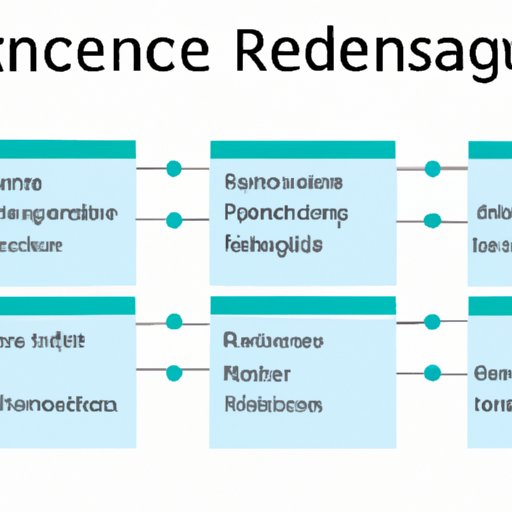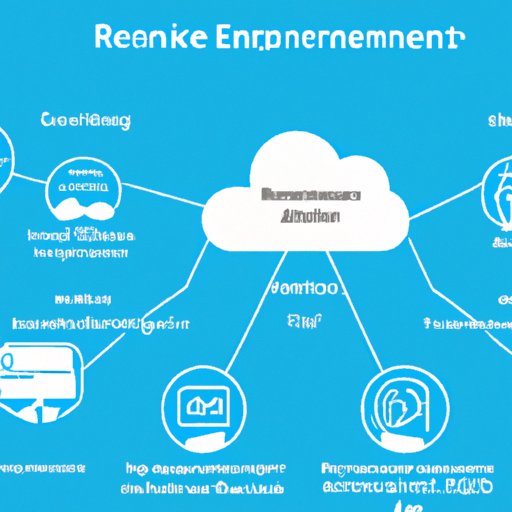Introduction
Reference architecture is an architectural blueprint that provides a common language and set of reusable design patterns to guide the development of applications and services. By leveraging reference architecture, businesses are able to streamline their software development processes, enhance scalability and portability, and improve quality assurance. In this article, we’ll explore the concept of reference architecture, including its benefits and best practices for implementation.

An Overview of Reference Architecture: What It Is and How It Can Help Your Business
Before we dive into the benefits of reference architecture, let’s take a closer look at what it is and how it can help your business.
What is Reference Architecture?
Reference architecture is a document or framework which defines the core elements of an architecture in terms of its components, their relationships, behaviors, and properties. Generally speaking, reference architecture is used to provide guidance and structure for designing and building applications and services. It helps to ensure that the architecture is consistent across all stages of the development process and allows developers to quickly understand the context of any given project.
How Reference Architecture Helps Businesses
Reference architecture is invaluable for businesses looking to streamline their software development processes, reduce time to market, and ensure consistent architectural standards. By leveraging reference architecture, businesses can save time, money, and resources as they develop and deploy new applications and services. Additionally, reference architecture makes it easier for businesses to scale their architectures and adapt to changing requirements.

Exploring the Benefits of Reference Architecture for Application Development
Now that you have a better understanding of what reference architecture is and how it can help your business, let’s take a closer look at some of the key benefits it offers for application development.
Streamlining Software Development Processes
One of the primary benefits of reference architecture is its ability to streamline software development processes. By providing a common language and set of reusable design patterns, reference architecture makes it easier for developers to quickly understand the context of any given project. This reduces the amount of time and effort required to develop and deploy applications, thus improving overall efficiency.
Enhancing Scalability and Portability
Another key benefit of reference architecture is its ability to enhance scalability and portability. By leveraging reference architecture, businesses are able to more easily scale their architectures to meet changing demands and needs. Additionally, reference architecture makes it easier for businesses to move their applications and services to other platforms or environments, thus improving overall flexibility.
Improving Quality Assurance
Finally, reference architecture can also be used to improve quality assurance. By establishing reusable design patterns, reference architecture ensures that applications and services adhere to established standards and best practices. This helps to reduce the risk of errors and improves overall quality. According to a survey by Gartner, “organizations that use reference architectures report a 20% reduction in defects and a 10% improvement in quality assurance testing.”

A Guide to Implementing a Reference Architecture Framework
Now that you have a better understanding of the benefits of reference architecture, let’s explore how to implement a reference architecture framework. Here are a few tips to get you started.
Identifying Core Components
The first step in implementing a reference architecture framework is to identify the core components of your architecture. This includes identifying the components and their relationships, behaviors, and properties. This will help you create a clear and concise framework that can be used to guide the development of your applications and services.
Developing a Common Language
Once you’ve identified the core components of your architecture, the next step is to develop a common language to describe them. This will ensure that everyone involved in the development process is on the same page and understands the context of the project. Developing a common language also makes it easier to communicate changes and updates throughout the development process.
Establishing Reusable Design Patterns
Finally, it’s important to establish reusable design patterns. By creating reusable design patterns, you can ensure that your architecture adheres to established standards and best practices. This will help to reduce the risk of errors and improve overall quality. Additionally, reusable design patterns allow you to quickly and easily make changes or updates to your architecture if needed.
Reference Architecture in Action: Real-World Examples
Now that you have a better understanding of how to implement a reference architecture framework, let’s take a look at some real-world examples. Here are two examples of reference architecture in action.
Example 1
One example of reference architecture in action is the Open Services for Lifecycle Collaboration (OSLC) framework. OSLC is an open source reference architecture framework that enables software development teams to collaborate more effectively. The framework provides a common language and set of reusable design patterns to share information between different tools and processes. This helps to streamline the development process, improve communication, and reduce errors.
Example 2
Another example of reference architecture in action is the Mobile Web Application Architecture (MWAA). MWAA is a reference architecture framework designed to help organizations build mobile web applications. The framework provides a common language and set of reusable design patterns to simplify the development process and ensure that applications adhere to established standards and best practices. Additionally, MWAA makes it easier for organizations to scale their architectures and move their applications to other platforms or environments.
Leveraging Reference Architecture to Improve Enterprise Agility
In addition to streamlining software development processes and enhancing scalability and portability, reference architecture can also be used to improve enterprise agility. Here are a few ways reference architecture can help.
Enhancing Flexibility and Adaptability
By leveraging reference architecture, businesses are better able to respond to changing demands and needs. By establishing reusable design patterns, reference architecture ensures that applications and services are flexible and adaptable. This makes it easier for businesses to quickly and easily make changes or updates to their architectures without having to start from scratch.
Reducing Time to Market
Reference architecture can also be used to reduce time to market. By streamlining software development processes and reducing the risk of errors, reference architecture helps businesses get their products and services to market faster. Additionally, reference architecture makes it easier for businesses to scale their architectures and move their applications to other platforms or environments, thus further reducing time to market.
The Role of Reference Architecture in DevOps
Reference architecture also plays an important role in DevOps. DevOps is a set of principles and practices that enable organizations to quickly and easily develop, deploy, and manage applications and services. By leveraging reference architecture, organizations are able to automate deployment and delivery pipelines, ensure consistent architectural standards, and reduce time to market.
Automating Deployment and Delivery Pipelines
Reference architecture can be used to automate deployment and delivery pipelines. By establishing reusable design patterns, reference architecture ensures that applications and services adhere to established standards and best practices. This makes it easier for organizations to quickly and easily deploy and deliver their applications and services.
Ensuring Consistent Architectural Standards
Additionally, reference architecture can be used to ensure consistent architectural standards. By providing a common language and set of reusable design patterns, reference architecture makes it easier for organizations to quickly understand the context of any given project. This helps to ensure that applications and services adhere to established standards and best practices.
Designing Cloud-Based Solutions Using Reference Architecture
Finally, let’s explore how to use reference architecture to design cloud-based solutions. Here are a few tips to get you started.
Understanding Cloud Computing Platforms
The first step in designing cloud-based solutions using reference architecture is to understand cloud computing platforms. It’s important to understand the features and capabilities of each platform in order to determine which one is best suited for your project. Additionally, understanding cloud computing platforms will help you to identify the components, relationships, and behaviors that need to be included in your reference architecture framework.
Adopting a Cloud-Based Reference Architecture
Once you have a better understanding of cloud computing platforms, the next step is to adopt a cloud-based reference architecture. This will allow you to streamline the development process, reduce time to market, and ensure consistent architectural standards. Additionally, a cloud-based reference architecture will make it easier for you to scale your architecture and move your applications and services to other platforms or environments.
Conclusion
In conclusion, reference architecture is an invaluable tool for businesses looking to streamline their software development processes, reduce time to market, and ensure consistent architectural standards. By leveraging reference architecture, businesses are able to save time, money, and resources as they develop and deploy new applications and services. Additionally, reference architecture makes it easier for businesses to scale their architectures and adapt to changing requirements. We hope this article has helped you gain a better understanding of reference architecture and its benefits for application development.
(Note: Is this article not meeting your expectations? Do you have knowledge or insights to share? Unlock new opportunities and expand your reach by joining our authors team. Click Registration to join us and share your expertise with our readers.)
